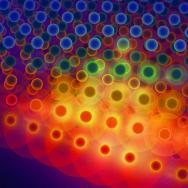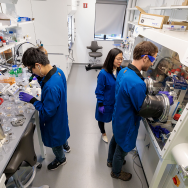While in the desert, one of humankind’s most pressing needs becomes even more dire: the need for water.
A team of scientists came together to address this problem using chemistry to develop a device that can extract water out of the air, even in dry climates like deserts. University of Chicago chemists created the device in collaboration with colleagues at the University of California, Berkeley, the University of Southern Alabama, General Electric and Humboldt University in Berlin. Their results were published Oct. 21 in Science.
The existing prototype of this water extraction device employed a kind of material called a metal-organic framework, which has empty pores for adsorbing water molecules similar to a sponge.
Although the basis for this device was already developed, the exact mechanism of how it worked at the atomic level was not well understood. But scientists thought that if they could more fully understand what was going on, they could boost the device’s performance even further. That was a task perfectly suited for UChicago’s Laura Gagliardi, the Richard and Kathy Leventhal Professor of Chemistry and Molecular Engineering and one of the most highly accomplished theoretical and computational chemists in the world.
Using theoretical and computational methods, Gagliardi and two members of her group—graduate student Saumil Chheda and postdoc WooSeok Jeong—could look at how the water molecules attach inside the framework at the atomic level. They worked in collaboration with the experimental group of Prof. Omar Yaghi at UC Berkeley and Prof. Joachim Sauer at Humboldt University.
The framework is formed by aluminum-based rods that are connected by “linker” molecules. As water begins to enter the framework, the first three water molecules attach to the linkers and the rods. The next water molecules bond mainly to the initially adsorbed water molecules, which can be thought as “seed water.”
Now that scientists have a solid understanding of the mechanism of how water binds to the framework, they can narrow down other frameworks with better performance.
However, improving this material can be a tricky process, because making the bonds stronger between the metal-organic framework and the water molecules doesn’t necessarily mean better output. “You want the material to adsorb water molecules, but the binding can't be too strong because then the water can’t be released and collected,” said Gagliardi, who is jointly appointed in UChicago’s Department of Chemistry and Pritzker School of Molecular Engineering.
A future goal of the research team is to test different material combinations to increase water uptake. The next step could be using artificial intelligence and machine learning to come up with materials having new compositions that weren’t previously considered.
While this device was originally developed to address the needs of those in combat situations in arid climates, the research has widespread potential for civilian use.
“Ideally, this would be an invention from which everyone could benefit,” said Gagliardi, “especially those living in regions experiencing water shortages associated with global climate change.”
Citation: “Evolution of water structures in metal-organic frameworks for improved atmospheric water harvesting.” Hankel et al, Science, Oct. 21, 2021.
Funding: Defense Advanced Research Projects Agency, Department of Energy Office of Science, National Institutes of Health, German Research Foundation (DFG)

